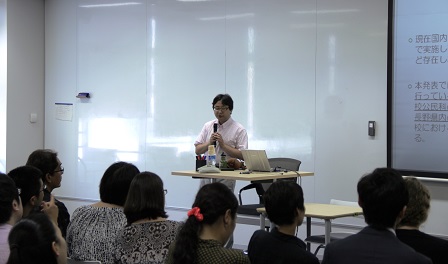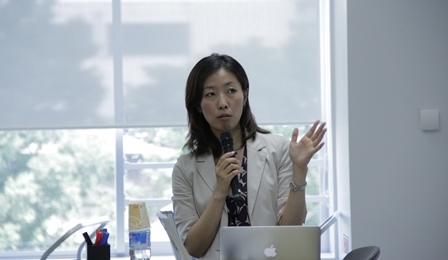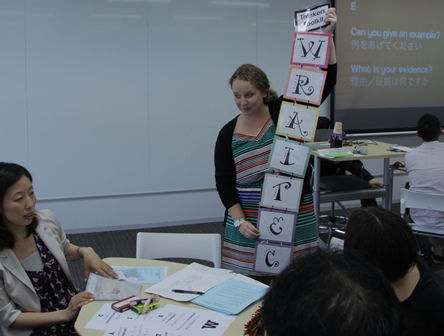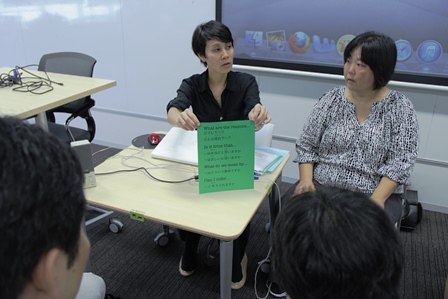[Report] P4C x UTCP: Workshop on Philosophy Education
On June 29, 2013, UTCP held a workshop on P4C (Philosophy for Children). UTCP invited Mr Yohsuke Tsuchiya of Ibaraki University, Dr Mitsuyo Toyoda of the University of Hyogo, Dr Benjamin Lukey of the University of Hawaii, Ms Staci Fong of Waikiki Elementary School, Ms Angela Kim of Waikiki Elementary School, Ms Rachel Susan Compton of Waimanalo Elementary & Intermediate School, Ms Katie Berger of Kailua High School, and Mr Jake Nichols of Kailua High School.
Mr Yohsuke Tsuchiya talked to us about his practice of P4C at Kaichi Junior High School. He gives fifteen P4C sessions a year for the thirteenth graders in five classes. The aim he has set for the students this year is "We don't give up thinking so easily", wanting the students to aquire such an attitude. The goal for the students is not to speak a lot. Rather, Mr Tsuchiya thinks the students should become able to think well before speaking, and become able to think even on their own. In the video he showed us, students were really enjoying discussing questions such as "What is the difference between adults and children?"
Dr Toyoda came across P4C when she was a student at the University of Hawaii. She launched a Japan-U.S. education exchange program in 2006, and has been promoting it. When Japanese teachers visit Hawaii, they practice moral education at Waikiki Elementary School. They also visit P4C sessions and participate in workshops. It has been Dr Toyoda's major interest to employ P4C in moral education. Since there is no conclusion to be reached in P4C, many Japanese teachers feel that it would be difficult to implement P4C in moral education. In the current Japanese moral education, teachers are given moral lessons to be taught in a class. Nonetheless, according to Dr Toyoda, as Japanese teachers accumulate experiences of P4C, they gradually begin to find ways to deal with such a problem.
Hawaiian teachers visit Japan to introduce P4C to Japanese school, to inspect school facilities in Japan, and so on. Dr Toyoda gave us some examples of the great results. One of the Hawaiian teachers was fascinated by a vegetable garden in a Japanese school, and started a "gardening project" in a school in Hawaii. A teacher who became interested in the Parent-Teacher Association started to hold dialogue sessions where parents can join. Hawaiian teachers also meet and have discussions with many Japanese teachers. In such occasions they explain the educational values of P4C, trying to increase the number of teachers who practice P4C. The only way to spread P4C is to attract teachers' interest. And to continue it, it is necessary to build a network of teachers. Hawaiian teachers do have worries as practitioners, so they have a network to encourage each other.
The second half of the event was a workshop given by the Hawaiian team. The team created four booths in the room, as they were so kind that they wanted to allow the participants to experience many aspects of the Hawaiian P4C.
The first booth for me was Dr Ben Lukey's. Dr Lukey has been making a great effort to cooperate with schools to constantly and continuously practice P4C. Reforms in education tend to be top-down. Teachers often have to follow what comes from the government. Dr Lukey says that in order to truly implement P4C in a school, change should be bottom-up. Dr Lukey trains teachers so that the teachers themselves can become philosophers, so that they can have P4C dialogues to teach their subject, and so that they can build the relationship of learning from each other with their students.
In the second booth, Ms Rachel Compton and Mr Jake Nichols were giving a session of making a "community ball". A "community ball" is a ball used in a P4C dialogue. One who has the ball can speak, and can hand it to someone else. Each person in the group took turns in winding wool, talking about himself or herself. By doing this in the first session of a P4C class, children start to have a sense of community and attachment to their own community ball. The session allowed me to experience what could only be conveyed through experience.
In the third booth, Ms Katie Berger introduced to us the "good thinker's toolkit". To be a good thinker, we need to think of a reason, inference, assumption, example, etc. Ms Berger especially stresses the importance of inferences and assumptions. There was a worksheet for thinking of inferences and assumptions, and Ms Berger let the participants try using this worksheet. Even we adults are not fully aware of our assumptions when drawing inferences, and once we become aware of our assumptions, we often think that they are wrong. I could see that the worksheet would enable children to go through such a process as they enjoy writing on the sheet.
In the final booth, Ms Angela Kim and Ms Staci Fong talked to us about "plain vanilla", which is one of the ways to have P4C dialogue. In "plain vanilla", children begin a dialogue simply by raising questions they want to think and discuss. For younger children who are not used to P4C dialogue, teachers use the toolkit as an aid. In actual dialogues, Ms Kim and Ms Fong say, teachers get truly amazed by children's questions and ideas.
The party after the workshop was an excellent occasion for introducing each other and for having an informal discussion. I would like to express my gratitude to the Uehiro Foundation for Ethics and Education, the guests from Hawaii and the speakers, who made the great event possible.
Report: Shogo Shimizu










